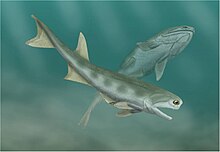| Cheirolepis Temporal range:
| |
|---|---|

| |
| Scientific classification | |
| Domain: | Eukaryota |
| Kingdom: | Animalia |
| Phylum: | Chordata |
| Class: | Actinopterygii |
| Order: | †Cheirolepidiformes Kazantzeva-Selezneva, 1977[2] |
| Family: | †Cheirolepididae Pander, 1860[1] |
| Genus: | †Cheirolepis Agassiz, 1835 |
| Type species | |
| †Cheirolepis trailli Agassiz, 1835
| |
| Other species | |
|
See text | |
Cheirolepis (from Greek: χείρ kheír, 'hand' and Greek: λεπίς lepis 'scale')[3] is an extinct genus of marine and freshwater ray-finned fish that lived in the Devonian period of Europe and North America. It is the only genus yet known within the family Cheirolepididae and the order Cheirolepidiformes. It was among the most basal of the Devonian actinopterygians and is considered the first to possess the "standard" dermal cranial bones seen in later actinopterygians.
Cheirolepis was a predatory freshwater and estuarine animal about 55 centimetres (22 in) long. It had a streamlined body with small, triangular ganoid scales similar to those of the Acanthodii. These scales had a basic structure typical of many early osteichthyans, with a superficial of ganoine overlying dentine, and a basal plate of bone.[4] Cheirolepis had well-developed fins which gave it speed and stability, and was probably an active predator. Based on the size of its eyes, it hunted by sight. Cheirolepis's jaws, lined with sharp teeth, could be opened very wide, allowing it to swallow prey two thirds of its own size.[5]
- ^ Cheirolepidae fossiilid.info (in Finnish)
- ^ Cheirolepiformes fossiilid.info (in Finnish)
- ^ Roberts, George (1839). An etymological and explanatory dictionary of the terms and language of geology. London: Longman, Orme, Brown, Green, & Longmans. p. 29. Retrieved 29 December 2021.
- ^ Zylberberg, L.; Meunier, F. J.; Laurin, M. (2016). "A microanatomical and histological study of the postcranial dermal skeleton of the Devonian actinopterygian Cheirolepis canadensis". Acta Palaeontologica Polonica. 61 (2): 363–376. doi:10.4202/app.00161.2015.
- ^ Palmer, D., ed. (1999). The Marshall Illustrated Encyclopedia of Dinosaurs and Prehistoric Animals. London: Marshall Editions. p. 34. ISBN 1-84028-152-9.